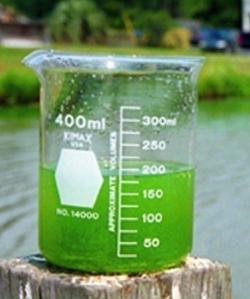 Algae are in the plant kingdom, but technically they are not plants. A diverse group of organisms, algae survive in even the harshest habitats. From the dry desert, to the Arctic Circle, to boiling springs, these organisms have found a way to extract enough from their environment to live. Algae range in size from microscopic to meters long and from single-celled to complex organisms that rival large plants. These organisms may look like true plants, but unlike plants, algae do not have roots or true stems and leaves. In Florida's freshwaters, algae are what make the water green. Green water is not necessarily undesirable, and neither are algae. In fact, algae are essential to the ecosystem and to life as we know it. Algae are a primary component of the food web, providing food for all types of animals, including fish, insects, mollusks, zooplankton (microscopic animals), and humans. There are microscopic algae, like phytoplankton; and there are macroalgae, visible to the naked eye. Algae occur naturally in all types of systems and can indicate the condition of an ecosystem. The mere presence of a species can indicate the amount and type of nutrients present.
Algae are in the plant kingdom, but technically they are not plants. A diverse group of organisms, algae survive in even the harshest habitats. From the dry desert, to the Arctic Circle, to boiling springs, these organisms have found a way to extract enough from their environment to live. Algae range in size from microscopic to meters long and from single-celled to complex organisms that rival large plants. These organisms may look like true plants, but unlike plants, algae do not have roots or true stems and leaves. In Florida's freshwaters, algae are what make the water green. Green water is not necessarily undesirable, and neither are algae. In fact, algae are essential to the ecosystem and to life as we know it. Algae are a primary component of the food web, providing food for all types of animals, including fish, insects, mollusks, zooplankton (microscopic animals), and humans. There are microscopic algae, like phytoplankton; and there are macroalgae, visible to the naked eye. Algae occur naturally in all types of systems and can indicate the condition of an ecosystem. The mere presence of a species can indicate the amount and type of nutrients present.
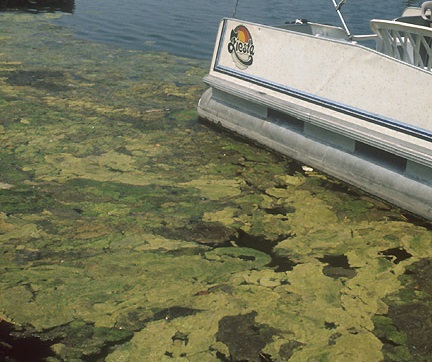
Some Important Types of Algae
Cyanophyta
Cyanophyta are the blue-green algae sometimes called "cyanobacteria" because they share many structural features with bacteria. They are the oldest (dating back 3.2 billion years) and one of the most important and ubiquitous groups of algae on the planet. This diverse group of algae can exist in all settings, from freshwater to terrestrial and from oligotrophic (low nutrient) to hypereutrophic (very high nutrient) environments. Some species of blue-green algae have a competitive advantage over other algae: the ability to fix nitrogen. Nitrogen fixation is the process of converting atmospheric nitrogen into usable nitrogen (ammonium). This characteristic allows these species to exist in areas where low nitrogen availability inhibits growth. Some groups of cyanobacteria are of special interest due to their ability to produce toxins potentially harmful to humans and animals.
Lyngbya
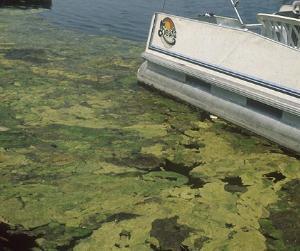
Lyngbya is one group of cyanobacteria of special concern. Long and hair-like, this filamentous alga can form large benthic and surface mats (blooms). Lyngbya normally grows in dense mats at the bottoms of nutrient-enriched lakes and spring-fed systems. These mats produce gasses during photosynthesis that often cause the mats to rise to the surface. At the surface, winds pile the algal mats against shorelines or in navigation channels. These mats can be several acres in size. Studies continue on what influences the cause and duration of lyngbya blooms. In some areas, the blooms cover so much of the pre-existing vegetation that they cause serious damage and eliminate other species. In some places in Florida, lyngbya smothers eelgrass, a preferred food of the endangered West Indian manatee. Some lyngbya species in this genus have been linked to a skin irritant that causes "swimmers' itch."
Microcystis
This spherical, unicellular alga can form a colony (group of cells). A microscopic alga, microcystis will turn the water blue-green when it grows to bloom proportions. Some strains of microcystis produce a toxin known as microcystin. In abundance, this toxin is potentially harmful to animals.
Chlorophyta
Chlorophyta is a large and varied group, commonly called green algae. The group includes unicellular, colonial, and filamentous varieties of algae.
Spirogyra
Spirogyra species are mostly freshwater and are commonly found in shallow waters around the edges of lakes and in ditches. This bright green, mat-forming filamentous alga is slimy and has no branching. It is called Spirogyra because of the way the chloroplasts wind around the cell.
Cladophora
Cladophora species are also bright green. They are branching, and feel coarse when touched.
Hydrodictyon
Hydrodictyon (also called water net) forms a net by joining five or six cylindrical cells. It can grow so large that the net can be seen by the naked eye. The best habitat is clear, eutrophic water, but the algae are also seen in irrigation ditches and even rice fields.
Bacillariophyta
Diatoms
Diatoms are a group of algae often considered the most beautiful because of the glass-like silica shell that houses them. These "shells" come in a wide variety of shapes and sizes and some species can form long chains when linked together. Their appearance is somewhat kaleidoscopic.
Xanthophyta
Commonly called yellow-green algae, many species belonging to this group were once placed within Chlorophyta. However, the classification was changed after close observation of the type of chlorophyll and its arrangement.
Vaucheria
Vaucheria species are filamentous, with branched cells; they grow in dense mats that look like carpets of green felt.
Charophyta
Charophyta species (commonly called the stoneworts) are considered an evolutionary link to higher plants. They occur in lakes, ponds, and streams attached to the bottom by rhizoids. This group is often mistaken for true plants because of the whorls of filaments at nodes along the shoot of the organism. Charophyta can form relatively large areas of dense underwater monocultures.
Chara
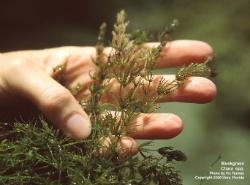
Chara
Chara is commonly called muskgrass because of its distinctive odor. This submersed alga grows in slow-moving rivers and lakes, and can overtake other natural vegetation. Chara has a strong musk or garlic odor when crushed. It is coarse to the touch.
Nitella, a submersed alga, grows in slow-moving rivers and lakes. It looks like Chara, but does not feel rough when touched. It is gray-green or yellow and grows in shallow and deep water attached to the substrate. Some species are a few inches tall; others are three feet or longer.
What causes an algae bloom?
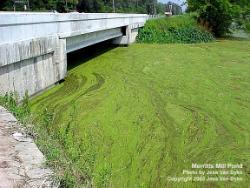
In Florida, chlorophyll (an indicator of algae presence) concentrations of more than 40 micrograms per liter are called an “algae bloom” or “algal bloom.” Algae blooms occur when algae grows quickly and densely, often in warm, nutrient-rich waters. Although these blooms are natural, many people don't like their appearance. Blooms associated with phytoplankton (microscopic algae) turn the water a certain color. Algae blooms are commonly green, but they can also appear blue-green, brown, red, or violet. Other blooms form clumps or dense mats that float on the surface of the water, grow attached to the bottom, or attach to plants.
Algae need light and nutrients, such as nitrogen and phosphorous, to grow. The level of growth or productivity often depends on the amount of nutrients in a system. Classification for the productivity of a system ranges from oligotrophic (low productivity and nutrients) to hypereutrophic (very high nutrients).Since algae need light to photosynthesize, light penetration into the water is another limiting factor.
Blooms can have far-reaching effects on the environment. Some become so dense they deplete oxygen levels. Decreased oxygen can cause hypoxia (low oxygen) or anoxia (no oxygen) and other organisms that use oxygen, such as fish, become stressed and may die. Other blooms can release toxins that are harmful to animals.
There is a general consensus that urban development, and the subsequent increase in nutrients, has increased the frequency and intensity of algal blooms in many regions of the world.
Controlling algal blooms
The most direct way to control algal blooms is to reduce the availability of nutrients. Most water management organizations throughout the world are actively pursuing a variety of nutrient-reduction strategies. However, for some aquatic ecosystems, nutrient reduction is impractical, ineffective, or too expensive. In some cases, chemical or biological treatments are helpful alternatives.
Chemical Treatments
Copper sulfate and chelated copper compounds are common chemical treatments to control algae. Chemical compounds that block the light required for algae growth (for example, dyes such as Aquashade) are also used to control blooms.
Municipal water authorities often treat drinking-water reservoirs when the algal count exceeds a certain number. Blue-green algae usually increase late in the summer, and often impart a foul taste and odor to the water. When this happens, copper herbicides are applied to lower the algal count, thus making the water more acceptable to drink.
Biological Treatments
The main biological treatment used today is fish stocking to control submersed and floating algae. Grass carp (Ctenopharyngodon idella) are mainly used for aquatic weeds and attached submersed algae, such as Nitella sp., and Chara sp. Although they do not readily eat filamentous algae, grass carp will eat Lyngbya. The silver carp (Hypophthalmichthys molitrix) has been an effective control for filamentous algae, including blue-green algae.
Both species of carp are non-native, and there are many restrictions to using them for weed control purposes; some states prohibit their use altogether. When they are allowed, use is restricted to triploid grass carp. Triploid grass carp have an extra set of chromosomes that render them sterile, prohibiting reproduction if the fish escapes into open water.
These fish are an economical choice and have proven effective in controlling the growth of algae in some circumstances. However, outcomes have been mixed when using carp to control algal blooms. Grass carp may consume beneficial vegetation, and leave the nuisance algae they were intended to eat. Research is being conducted on how and why feeding preferences change over time and vary from one lake to another.
Physical Treatments
Physical treatments for algae in ponds include aeration and airlifts. While aeration does not kill or remove algae from the water, it stirs and oxygenates the water, and can shift conditions from toxic and foul-smelling blue-green algae to preferred green algae species. The resultant algal population is usually not as dense or toxic to other organisms in the ponds.
Mechanical Treatments
Harvesters are sometimes used to skim dense mats of blue-green algae (Lyngbya) from the water surface. Lyngbya typically grows in dense mats at the bottoms of nutrient-enriched lakes and spring-fed systems. During photosynthesis, these mats produce gasses that cause them to rise to the surface. Winds pile the algal mats, sometimes several acres in size, against shorelines or in navigation channels. Managers have developed a process called "grubbing" whereby harvesting machines lift the mats off of submersed plants such as native eelgrass, without cutting the eelgrass. By removing the blanket of Lyngbya from the eelgrass, the native plants are able to grow unobstructed. Eelgrass is an important food source for manatees in the Crystal and Homosassa Rivers.

 Plant Management in Florida Waters
Plant Management in Florida Waters